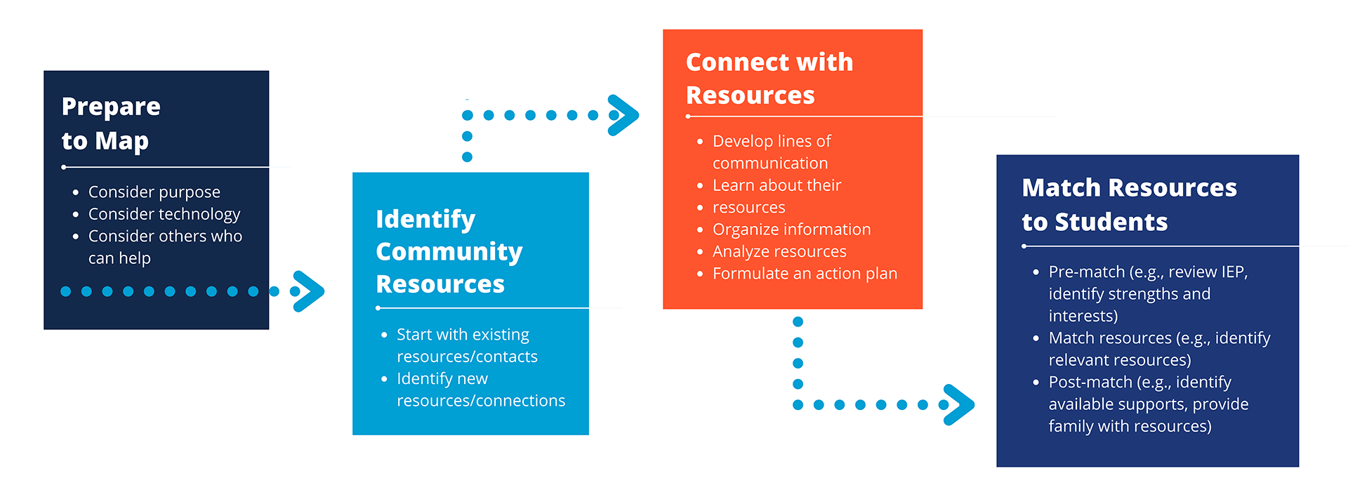.png?sfvrsn=8ece0f91_0)
Community Resource Mapping
The Individuals with Disabilities Education Act (IDEA, 2004) and the Every Student Succeeds Act (ESSA, 2015) require schools to prepare students for adult life. Specifically, IDEA (2004) mandates that students with disabilities are prepared for postsecondary education/training, employment, and independent living, while ESSA (2015) mandates all students exit school college and career ready. Additionally, IDEA (2004) requires schools to include outside agencies in the transition planning process. Special education teachers are often responsible for facilitating collaboration between the student, family, school, and outside agencies. To foster these collaborations, special educators must be aware of the community resources available to support their students. One effective strategy for identifying resources and supports for students with disabilities is community resource mapping (Carter et al., 2009, 2010; Flanagan & Bumble, 2022).
Related ICTW Resources
What is Community Resource Mapping?
Community resource mapping, also referred to as asset mapping or scanning the environment, is a process for identifying resources in a community that can support students as they transition from school to adulthood. Through community resource mapping, information is gathered about the types of resources that exist in a community (e.g., resources related to employment, postsecondary education, vocational training, transportation, independent living, leisure, health care). This information is then used to identify specific opportunities and supports for students that match their interests, needs, and postschool goals. For example, information learned about transportation resources may present new options for supporting a student to access work-based learning experiences in the community.
Research on Community Resource Mapping
Community resource mapping is an effective process for identifying and maximizing resources in both urban and rural settings. The process is flexible, allowing information to be collected through questionnaires, interviews, in-person visits, and/or virtual methods (Crane & Mooney, 2005; Flanagan & Bumble, 2022). For example, Google My Maps (mymaps.google.com), a free tool, can be easily used to identify and examine community resources (Flanagan & Bumble, 2022). Simply type an address, business, or town into Google My Maps, and a visual map of businesses and organizations near that location will appear. Google My Maps has an option to document notes and commentary within each map, which can then be shared with others.
Community resource mapping can serve a variety of purposes in preparing students for a seamless transition from high school to adult life, including the transition from school to work. For example, community resource mapping has been used to help develop summer work experiences and career development opportunities for students with significant disabilities (Carter et al., 2009, 2010). It can also be used during Individualized Education Program (IEP) meetings to highlight options available in the community that align with a student’s postsecondary goals (Flanagan & Bumble, 2022). Table 1 offers suggestions of possible community resources that might be obtained from the mapping process.
Table 1.
Possible Community Resources
Citizen Associations | Community Organizations | Community Populations | Institutions | Private Sector |
| Community leaders Local leaders Local officials Local politicians Neighborhood organizations | Advocacy groups Churches Clinics Food kitchens Housing organizations | College students Local artists Local musicians Volunteers | Community colleges Libraries Parks Pools | Local businesses Chambers of commerce Banks |
Note. Based on the Community Tool Box, University of Kansas (2022)
Guidelines for Practice
Community resource mapping consists of the following four steps: (1) prepare to map, (2) identify community resources, (3) connect with resources, and (4) match resources to students. During step one, prepare to map, clarify the purpose and objectives of mapping (e.g., employment for students with significant disabilities). In addition, consider how technology will be used (e.g., Google My Maps; Flanagan & Bumble, 2022) and who will be involved with the mapping process (e.g., teachers, students, parents, community members). In step two, identify community resources, investigate the resources that exist in the community. Examine both pre-existing resources that you already access (e.g., Division of Rehabilitation Services, local transportation) as well as new resources that align with the purpose of the mapping. Once all resources are identified, step three is to connect with resources. During this step, learn about the available resources, identify overlapping or missing resources, and formulate an action plan regarding how to partner with organizations. Finally, in step four, match resources to students, examine your student’s IEP. Match the available resources with the student’s individualized needs, partner with community resources, and share information about resources with students and families. Figure 1 provides an “at-a-glance” image of the community resource mapping process.
Figure 1.
Steps to Community Resource Mapping

Additional Resources
References
Carter, E. W., Trainor, A. A., Cakiroglu, O., Swedeen, B., & Owens, L. A. (2010). Availability of and access to career development activities for transition-age youth with disabilities. Career Development for Exceptional Individuals, 33(1), 13-24. https://doi.org/10.1177/0885728809344332
Carter, E. W., Trainor, A. A., Ditchman, N., Swedeen, B., & Owens, L. (2009). Evaluation of a multicomponent intervention package to increase summer work experiences for transition-age youth with severe disabilities. Research and Practice for Persons with Severe Disabilities, 34(2), 1-12. https://doi.org/10.2511/rpsd.34.2.1
Crane, K., & Mooney, M. (2005). Essential tools: Community resource mapping.
https://files.eric.ed.gov/fulltext/ED495860.pdf
Every Student Succeeds Act of 2015, 129 U.S.C. 1802 et seq. (2015). https://www.congress.gov/114/plaws/publ95/PLAW-114publ95.pdf
Flanagan, M. F., & Bumble, J. L. (2022). Mapping Assets for Postschool Success (MAPS): Using digital resource mapping to enhance the transition process. TEACHING Exceptional Children, advanced online publication. https://doi.org/10.1177/00400599211068143
Individuals with Disabilities Education Act of 2004, 20 U.S.C. § 1400 et seq. (2004). https://www.govinfo.gov/content/pkg/STATUTE-118/pdf/STATUTE-118-Pg2647.pdf